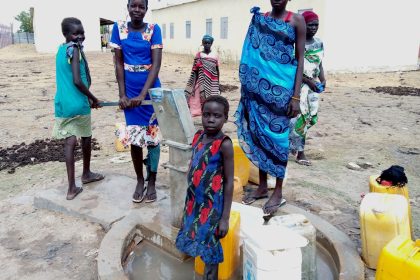Uganda’s total $10bn debt remains manageable
January 9, 2019—Uganda’s total public debt of $10.7 billion remains manageable and there is little concern that new infrastructure assets built with foreign borrowings will be snapped up by creditors for inability of the government to repay loans.

Kasaija said Ugandans should not worry about the government’s ability to repay foreign loans.
China is Uganda’s biggest bilateral lender and has provided the bulk of money for new power and road projects.The government is also trying to borrow another $2 billion for from the China Eximbank for building a new Standard Gauge Railway link between Malaba at the border the Kenya and the capital, Kampala.
Finance minister, Matia Kasaija, was reacting to an Auditor General report indicating that government debt was getting out of hand and that Uganda could lose assets to creditors due to failure to service its loans.
“Uganda’s public debt is sustainable, and is projected to remain sustainable in the medium to long term. The debt levels are comfortably below the international sustainability thresholds which is below 50 pc for the debt-to-GDP ratio, beyond which debt starts getting unsustainable, and is significantly below the sub-Saharan average of 45.4pc debt to GDP,” Kasaija told a news conference on Tuesday. Currently, Uganda’s debt-to-GDP ratio hovers about 40 pc.
He said total debt stock, both domestic and external now amounted to $10.7 billion, equivalent to UGX 41.3 trillion as of June 2018. He said, “Out of this, external debt disbursed and outstanding accounted for 67.2pc or $7.2 billion (UGX 27.9 trillion) while domestic debt is about UGX 13.3 trillion.”
According to the latest World Bank Outlook for 2019, debt vulnerabilities in low-income countries are rising. While borrowing has enabled many countries to tackle important development needs, the median debt-to-GDP ratio of low-income countries has climbed, and the composition of debt has shifted toward more expensive market-based sources of financing.
The bank suggests these economies should focus on mobilizing domestic resources, strengthening debt and investment management practices and building more resilient macro-fiscal frameworks.
Kasaija said compared to other developing countries, Uganda is better off because most of its foreign debt has been contracted on concessional terms, unlike other countries in the continent who have contracted considerable commercial debt like Eurobonds. In East Africa, Kenya is the most exposed and late last year was negotiating to raise another $2.8 billion from issuing Eurobonds. Djibouti’s debt-to-GDP has already surpassed 80 pc with most of it owed to China.
Kasaija said Uganda has been mostly borrowing on concessional terms. “I want to inform the country that Uganda’s public debt has been provided largely by multilateral creditors who offer concessional terms that include a grant element of more than 50 pc with an average maturity of over 35 years and a grace period not less than six years coupled with relatively low interest rates below 1.5 percent annually,” Kasaija said.
During his budget proposals six months ago, Kasaija said in line with the Medium Term Debt Strategy, the government looks for concessional loans while restricting commercial loans to the financing of infrastructure and self-financing projects. This will help to ensure long term debt sustainability.
However the World Bank country office in Kampala said in its 11th Uganda Economic Update published last May, Uganda has reached a critical point in its development.
The report states, ‘Aid flows have slowed, and public debt is rising, and is expected to increase above 40 pc of GDP by the end of 2019. The Government’s ability to borrow domestically is also constrained, due to the crowding out effect this can have on private sector credit growth. At the same time, however, Uganda needs to scale up the financing of important infrastructure, and continue to build human capital through the provision of better education and health services. Thus, to stay its development course and not compromise fiscal stability, the country needs to urgently increase the mobilization of domestic revenues’.
A sustainable external debt status means a country servicing its obligations in full without accumulating any arrears, having recourse to rescheduling or to debt cancellation, while allowing for an acceptable level of economic growth.
Uganda’s leading bilateral creditors are China through the Eximbank and the Japan International Corporation Agency (JICA). But Kasaija said these lenders offer preferential terms with a grant element that range between 20 pc and above 35 pc.
Kasaija said, ” Moreover, with the investments that our debt is financing, the capacity of our economy to service its debt obligations will significantly increase. In addition, the increase in revenue arising from implementation of the new Domestic Revenue Mobilization Strategy will reduce the country’s borrowing requirements in the future.”
He said all debt payments are programmed and prioritized to ensure that the money is paid as and when it falls due. Kasaija said, “The risk for government defaulting on debt repayment is nonexistent in our budgeting cycle and should not be of concern to anyone.”
he said the government will continue borrowing cautiously and selectively for infrastructure development with intention to grow the economy which in turn boosts domestic revenues, promote exports to earn foreign exchange which it will use to service the external debt thus enhancing the capacity for debt sustainability.

 African Heads of state head to South Korea next week for Summit talks
African Heads of state head to South Korea next week for Summit talks
 Trading leads as main source of income for Ugandans
Trading leads as main source of income for Ugandans
 New leadership for bankers’ umbrella as total assets top $12 billion
New leadership for bankers’ umbrella as total assets top $12 billion
 Uganda-Tanzania announce date for second joint business forum
Uganda-Tanzania announce date for second joint business forum
 Unpacking results-based financing: balancing strengths with weaknesses
Unpacking results-based financing: balancing strengths with weaknesses
 Big fish in small pond Stanbic notches up $100m profit for 2023 topping previous figure by 15%
Big fish in small pond Stanbic notches up $100m profit for 2023 topping previous figure by 15%
